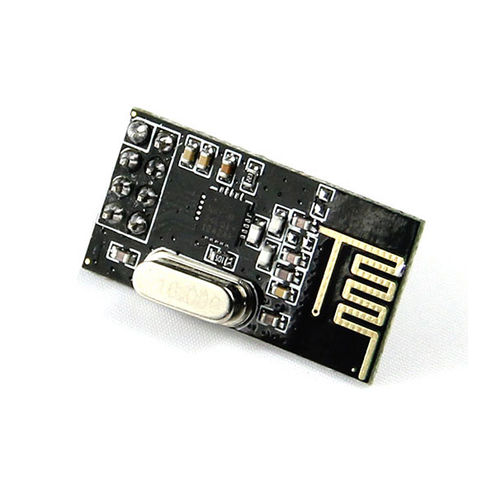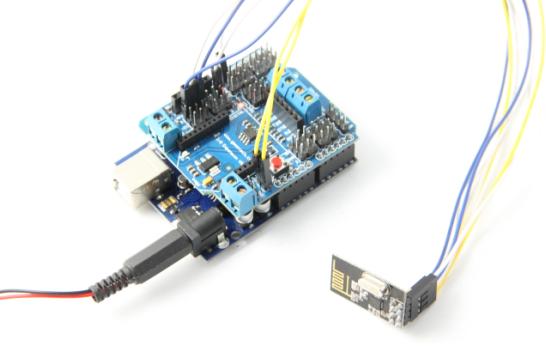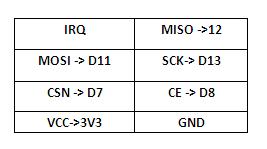Difference between revisions of "2.4Ghz nRF24L01 RF Transceiver Module"
(→How to buy) |
(→Introduction) |
||
| (One intermediate revision by the same user not shown) | |||
| Line 1: | Line 1: | ||
==Introduction== | ==Introduction== | ||
| − | [[File: | + | [[File:Nrf2.4G.jpg|500px|]] |
The nRF24L01 is a single chip 2.4GHz transceiver with an embedded baseband protocol engine (Enhanced ShockBurst™), designed for ultra low power wireless applications. The nRF24L01 is designed for operation in the world wide ISM frequency band at 2.400 - 2.4835GHz. An MCU (microcontroller) and very few external passive components are needed to design a radio system with the nRF24L01.The nRF24L01 is configured and operated through a Serial Peripheral Interface (SPI.) Through this interface the register map is available. The register map contains all configuration registers in the nRF24L01 and is accessible in all operation modes of the chip.The embedded baseband protocol engine (Enhanced ShockBurst™) is based on packet communication and supports various modes from manual operation to advanced autonomous protocol operation. Internal FIFOs ensure a smooth data flow between the radio front end and the system’s MCU. Enhanced Shock-Burst™ reduces system cost by handling all the high-speed link layer operations.The radio front end uses GFSK modulation. It has user configurable parameters like frequency channel,output power and air data rate.The air data rate supported by the nRF24L01 is configurable to 2Mbps. The high air data rate combined with two power saving modes makes the nRF24L01 very suitable for ultra low power designs.Internal voltage regulators ensure a high Power Supply Rejection Ratio (PSRR) and a wide power supply range. | The nRF24L01 is a single chip 2.4GHz transceiver with an embedded baseband protocol engine (Enhanced ShockBurst™), designed for ultra low power wireless applications. The nRF24L01 is designed for operation in the world wide ISM frequency band at 2.400 - 2.4835GHz. An MCU (microcontroller) and very few external passive components are needed to design a radio system with the nRF24L01.The nRF24L01 is configured and operated through a Serial Peripheral Interface (SPI.) Through this interface the register map is available. The register map contains all configuration registers in the nRF24L01 and is accessible in all operation modes of the chip.The embedded baseband protocol engine (Enhanced ShockBurst™) is based on packet communication and supports various modes from manual operation to advanced autonomous protocol operation. Internal FIFOs ensure a smooth data flow between the radio front end and the system’s MCU. Enhanced Shock-Burst™ reduces system cost by handling all the high-speed link layer operations.The radio front end uses GFSK modulation. It has user configurable parameters like frequency channel,output power and air data rate.The air data rate supported by the nRF24L01 is configurable to 2Mbps. The high air data rate combined with two power saving modes makes the nRF24L01 very suitable for ultra low power designs.Internal voltage regulators ensure a high Power Supply Rejection Ratio (PSRR) and a wide power supply range. | ||
| − | |||
==Specification== | ==Specification== | ||
Latest revision as of 07:56, 28 August 2014
Introduction
The nRF24L01 is a single chip 2.4GHz transceiver with an embedded baseband protocol engine (Enhanced ShockBurst™), designed for ultra low power wireless applications. The nRF24L01 is designed for operation in the world wide ISM frequency band at 2.400 - 2.4835GHz. An MCU (microcontroller) and very few external passive components are needed to design a radio system with the nRF24L01.The nRF24L01 is configured and operated through a Serial Peripheral Interface (SPI.) Through this interface the register map is available. The register map contains all configuration registers in the nRF24L01 and is accessible in all operation modes of the chip.The embedded baseband protocol engine (Enhanced ShockBurst™) is based on packet communication and supports various modes from manual operation to advanced autonomous protocol operation. Internal FIFOs ensure a smooth data flow between the radio front end and the system’s MCU. Enhanced Shock-Burst™ reduces system cost by handling all the high-speed link layer operations.The radio front end uses GFSK modulation. It has user configurable parameters like frequency channel,output power and air data rate.The air data rate supported by the nRF24L01 is configurable to 2Mbps. The high air data rate combined with two power saving modes makes the nRF24L01 very suitable for ultra low power designs.Internal voltage regulators ensure a high Power Supply Rejection Ratio (PSRR) and a wide power supply range.
Specification
- Power supply :1.9V~3.6V
- Working current:13.5mA at 2Mbps / 11.3mA at 0dBm output power
- IO counts :8
- Sensitivity :-85dBm at 1Mbps
- Emission distance :70~100 meter at 256kbps
- Data rate :256kbps / 1Mbps / 2Mbps
- Commuinitcation mode :Enhanced ShockBurst TM / ShockBurst TM
- Working mode :Power Down Mode / Standby Mode / RX Mode / TX Mode
- Temperatures :Operating:-40°C ~ 85°C / Storage:-40°C ~ 125°C
Pin definition
Usage
First of all, you need two Arduino boards and at least two RF modules, one to transmit and the other to receive. If you don’t have, you can get them in our store in a very low cost. (Order nRF24L01 module)If you use a standard Arduino board, you should use the Arduino board’s 3.3V pin to provide power. Beacuse the nRF24L01 module is worked at 1.9-3.6V voltage level.
The Demo pins to Arduino:
Document
How to buy
Click here to buy 2.4Ghz nRF24L01+ RF Transceiver Module



